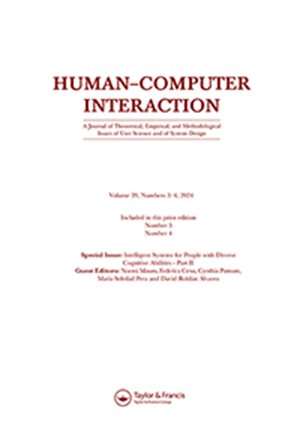Avoiding mixed messages: research-based fact-checking the media portrayals of voice user interfaces for older adults
IF 4.5
2区 工程技术
Q1 COMPUTER SCIENCE, CYBERNETICS
引用次数: 3
Abstract
It is often suggested that older adults (those 60 years or older) constitute a viable target market for voice user interfaces (VUIs) and that VUIs can provide many benefits for older adults. The mass media has been found to support this view, based on recent investigation on mass media’s portrayals of VUIs for older adults (Sin, Munteanu et al., 2021). The mass media was also found to suggest that older adults’ perceptions, acceptance, and adoption of VUIs rest on issues of data privacy, trust in the organizations behind VUIs, life fit and benefits conferred by VUIs, and market and government actions. This messaging can directly and indirectly influence older adults’ perceptions, and subsequent adoption, of voice user interfaces (Boothroyd, 2014; Rogers, 2010), much in the way that mass media has influenced adoption of other technologies when they emerged, such as smartphones (Yoo et al., 2010) and television (Weber & Evans, 2002). However, it is not yet known to what degree the claims made by the mass media about VUIs are supported by current academic research. It is possible that the mass media is propagating claims about VUIs that are not supported by academic literature. This is important because discrepancies between media messaging and academic findings may highlight aspects related to VUI adoption that are either not yet investigated by academic research or are portrayed in the mass media in a manner not supported by (or even contradictory to) scientific knowledge. Shedding light upon these knowledge gaps and addressing them are vital steps for the design of VUI systems in a manner that is conscious of factors that can influence VUI adoption (herein referred to as ‘adoption factors’) and sociotechnical influences of adoption (such as mass media messaging). Failure to design in a manner that sufficiently accounts for adoption factors can result in older adults’ rejection of VUI systems and, perhaps, other forms of digital technology as well (Norman, 2013; Whitenton, 2018). Furthermore, unsubstantiated claims in mass media messaging may interplay with the commercial industry’s development of VUIs, which is not only progressing much faster than academic-based research but may also be moving in a different direction than academia (Murad et al., 2019). The vigorous mass media messaging and industry push for “voice-first” devices may cause VUIs, which are positioned as greatly benefiting older adults, to instead further marginalize them with design features that exacerbate feelings of frailty, social isolation, and loneliness (Sin, Franz et al., 2021; Sin & Munteanu, 2020). For our investigation, we adopt a sociotechnical perspective (as opposed to issues of engineering performance or accuracy) of VUIs for older adults. The study of technology as sociotechnical systems (i.e., as systems with technological, social, cultural, historical, economic, and political dimensions) accounts for forces external to the technology alone as drivers of technology design and development and emphasizes the role of humans in this process (Neves & Vetere, 2019). We避免混淆信息:基于研究的事实核查媒体对老年人语音用户界面的描述
通常认为,老年人(60岁或以上)是语音用户界面(VUIs)的可行目标市场,并且VUIs可以为老年人提供许多好处。根据最近对大众媒体对老年人VUIs的描述的调查,发现大众媒体支持这一观点(Sin, Munteanu et al., 2021)。大众媒体还发现,老年人对VUIs的看法、接受和采用取决于数据隐私、对VUIs背后组织的信任、VUIs赋予的生活适应性和利益,以及市场和政府行为。这种信息传递可以直接或间接地影响老年人对语音用户界面的看法和随后的采用(Boothroyd, 2014;Rogers, 2010),就像大众媒体在其他技术出现时影响了它们的采用一样,比如智能手机(Yoo et al., 2010)和电视(Weber & Evans, 2002)。然而,目前尚不清楚大众媒体对VUIs的说法在多大程度上得到了当前学术研究的支持。有可能大众媒体正在宣传没有得到学术文献支持的关于VUIs的说法。这一点很重要,因为媒体信息和学术发现之间的差异可能会突出与VUI采用有关的方面,这些方面要么尚未得到学术研究的调查,要么在大众媒体中以不受科学知识支持(甚至与科学知识相矛盾)的方式进行描述。揭示这些知识差距并解决它们是VUI系统设计的重要步骤,以一种意识到可能影响VUI采用的因素(此处称为“采用因素”)和采用的社会技术影响(如大众媒体消息传递)的方式。未能以充分考虑采用因素的方式进行设计可能导致老年人拒绝VUI系统,也许也会拒绝其他形式的数字技术(Norman, 2013;Whitenton, 2018)。此外,大众媒体信息中未经证实的说法可能与商业行业的VUIs发展相互作用,这不仅比基于学术的研究进展得快得多,而且还可能朝着与学术界不同的方向发展(Murad等人,2019)。蓬勃发展的大众媒体信息和行业对“语音优先”设备的推动可能会导致定位为极大地有利于老年人的VUIs,而不是进一步边缘化他们的设计特征,加剧了脆弱,社会孤立和孤独感(Sin, Franz等人,2021;Sin & Munteanu, 2020)。在我们的调查中,我们采用了社会技术视角(与工程性能或准确性的问题相反)对老年人的VUIs。将技术作为社会技术系统(即具有技术、社会、文化、历史、经济和政治维度的系统)进行研究,将技术外部的力量单独作为技术设计和开发的驱动因素,并强调人类在这一过程中的作用(Neves & Vetere, 2019)。我们
本文章由计算机程序翻译,如有差异,请以英文原文为准。
求助全文
约1分钟内获得全文
求助全文
来源期刊

Human-Computer Interaction
工程技术-计算机:控制论
CiteScore
12.20
自引率
3.80%
发文量
15
审稿时长
>12 weeks
期刊介绍:
Human-Computer Interaction (HCI) is a multidisciplinary journal defining and reporting
on fundamental research in human-computer interaction. The goal of HCI is to be a journal
of the highest quality that combines the best research and design work to extend our
understanding of human-computer interaction. The target audience is the research
community with an interest in both the scientific implications and practical relevance of
how interactive computer systems should be designed and how they are actually used. HCI is
concerned with the theoretical, empirical, and methodological issues of interaction science
and system design as it affects the user.
 求助内容:
求助内容: 应助结果提醒方式:
应助结果提醒方式:


